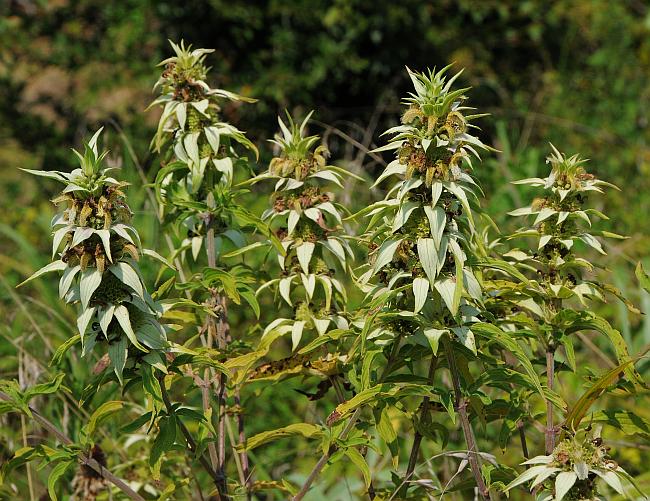Monarda punctata L.
Dotted Beebalm

Native
CC = Amb
CW = 5
MOC = 12
© SRTurner
Monarda punctata L.Dotted Beebalm | |
 |
Native CC = Amb CW = 5 MOC = 12 |
© SRTurner |
|
Family - Lamiaceae Habit - Annual or perennial forb. Stem - Ascending to erect, to 50 cm, 4-angled, moderately to densely pubescent with minute, downward-curved hairs, rarely with sparse to dense, longer, bristly spreading hairs, sometimes only at the nodes.
Leaves - Opposite, simple, sessile or with petioles to 15 mm long, the median leaves the largest. Leaf blades 2-9 cm long, usually lanceolate, rounded or angled at the base, sharply pointed at the tip, the margins with moderately to widely spaced, fine teeth, usually also hairy, the surfaces sparesely to densely pubescent with minute, curved hairs, occasionally also with longer, somewhat woolly hairs along the main veins.
Inflorescence - 2-7 flower clusters forming an interrupted terminal spike, the bracts 15-40 mm long, oblong or ovate, the margins entire but hairy (at least near the base), the surfaces usually minutely hairy, whitish to pinkish- or purplish-tinged. Innermost bracts 3-8 mm long, linear, the margins hairy.
Flowers - Calyces 5-8 mm long, the outer surface sparsely to densely pubescent with minute, curled hairs, densely bristly-hairy in the throat, the lobes 1.0-1.5 mm long, triangular, sharply pointed but lacking a bristlelike extension. Corollas 15-28 mm long, cream-colored to pale yellow, the lips with prominent purplish to maroon spots or mottling, moderately to densely pubescent with fine nonglandular hairs externally, also dotted with sessile glands, the lips with longer, denser hairs toward the tips, hairy in the throat, slightly shorter than the tube, the upper lip strongly arched downward, the lower lip 3-lobed with a pair of short lateral lobes and a flangelike, oblong (sometimes shallowly notched) extension at the tip of the central lobe. Stamens not exserted from the corolla, hidden under the upper corolla lip.
Fruits - Dry schizocarps, separating into usually 4 nutlets, these 1.2-1.5 mm long, oblong-obovoid, the surface yellowish brown, glabrous. Flowering - June - October. Habitat - Sand prairies, crop field margins, roadsides, open disturbed areas, usually in sandy soil. Origin - Native to the U.S. Lookalikes - Broadly, other species of Monarda and Blephilia. Other info. - This species is uncommon in Missouri, known from only a few scattered counties, usually in expanses of sandy soil. It is somewhat more common in states to our south and west, within the south-central portion of the continental U.S. A number of varieties have been defined by various authors, but these divisions are messy and complex with overlapping characters and intermediate forms. Three infraspecific forms have been recognized in Missouri: var. arkansana, var. occidentalis, and var. villicaulis. These are differentiated based on subtle differences in pubescence and calyx lobe shape. Most of the photos above probably depict var. occidentalis. Photographs taken at Sand Prairie Conservation Area, Scott County, MO, 7-30-2015, near Hwy 3 and Double Springs Creek, Atoka County, OK, 7-26-2016, at Ellis Island, near West Alton, St. Charles County, MO, 7-3-2017, at Illiniwek Village State Historic Site, Clark County, MO, 7-8-2017, and near Loda Lake, Newaygo County, MI, 8-29-2020 (SRTurner). |